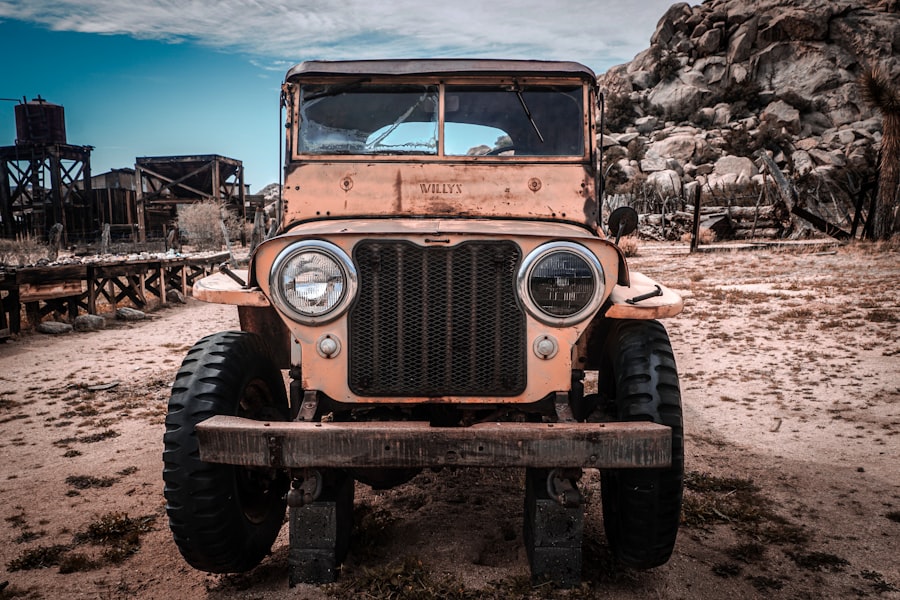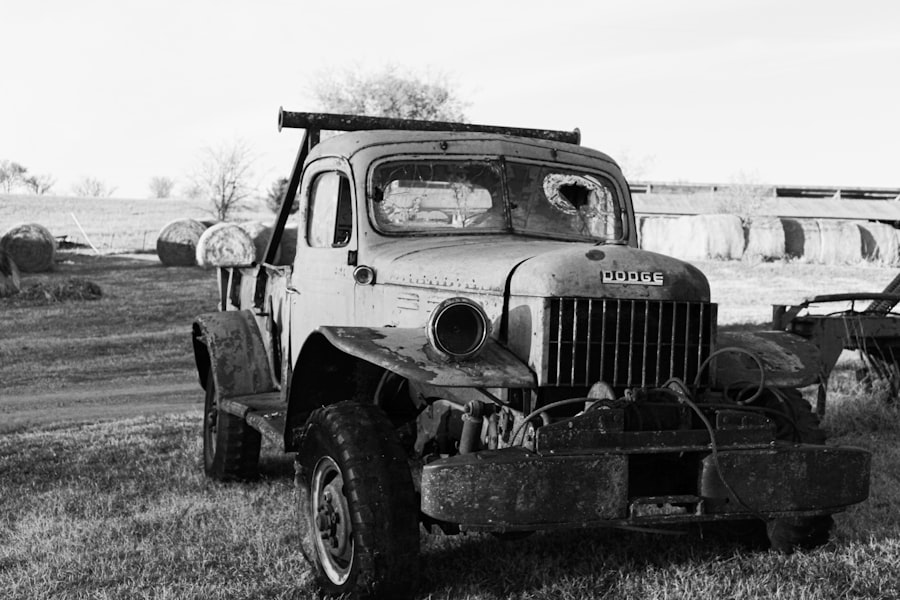The Jeep’s origins can be traced back to the early 1940s, a time when the United States was on the brink of entering World War
The military required a versatile, lightweight vehicle that could traverse rough terrains and carry troops and supplies. In response to this need, the U.S. Army issued a request for a prototype vehicle that could meet specific criteria, including a four-wheel drive system, a sturdy frame, and the ability to carry a payload of up to 1,200 pounds.
Several manufacturers submitted designs, but it was Willys-Overland that ultimately won the contract with its innovative model, the Willys MB.
The name “Jeep” is believed to have originated from the phonetic pronunciation of “G.P.” for “General Purpose” vehicle, although some also attribute it to the character Eugene the Jeep from the Popeye comic strip. Regardless of its etymology, the Jeep quickly became synonymous with ruggedness and reliability. Its design featured a distinctive grille and round headlights, which would become iconic in the automotive world.
As production ramped up, the Jeep became an essential tool for the military, setting the stage for its future as a cultural icon.
Key Takeaways
- The Jeep was originally designed for military use, with its origins dating back to the 1940s.
- During World War II, the Jeep played a crucial role in various military operations, serving as a versatile and reliable vehicle for troops.
- The Jeep became a symbol of American innovation and strength, representing the country’s ability to produce practical and durable machinery.
- Post-war propaganda often depicted the Jeep as a symbol of American superiority and resilience, further solidifying its iconic status.
- The Jeep has become a prominent feature in popular culture, appearing in films, music, and literature, and has become synonymous with adventure and freedom.
The Role of the Jeep in World War II

During World War II, the Jeep played a pivotal role in various military operations. Its compact size and exceptional maneuverability allowed it to navigate through challenging landscapes, from muddy fields to rocky hillsides. Soldiers relied on the Jeep for reconnaissance missions, troop transport, and even as a mobile command center.
The vehicle’s versatility made it indispensable on the battlefield, and it quickly earned a reputation for being able to handle whatever was thrown at it. The Jeep’s contributions were not limited to combat scenarios; it also served as a vital logistical support vehicle. It transported supplies, ammunition, and medical personnel to frontline troops, ensuring that soldiers had what they needed to sustain their efforts.
The vehicle’s ability to traverse difficult terrain meant that it could reach areas where larger vehicles could not, making it an essential asset in wartime operations. As a result, the Jeep became a symbol of American military might and ingenuity during this tumultuous period.
The Jeep as a Symbol of American Ingenuity and Strength
| Aspect | Description |
|---|---|
| Origin | Developed by American Bantam Car Company in 1940s |
| Usage | Used by US military during World War II |
| Iconic Status | Symbol of American strength and resilience |
| Popularity | Remains popular in off-road and adventure communities |
| Evolution | Continues to be produced with modern advancements |
The Jeep’s design and functionality exemplified American ingenuity during a time of crisis. Engineers and designers worked tirelessly to create a vehicle that could withstand the rigors of war while remaining affordable and easy to produce. The success of the Jeep was not just in its mechanical capabilities but also in its ability to embody the spirit of resilience and determination that characterized the American people during World War
As soldiers returned home after the war, they brought with them stories of their experiences with the Jeep. This connection between the vehicle and the soldiers who drove it further solidified its status as an emblem of American strength. The Jeep was not merely a machine; it represented the sacrifices made by countless individuals in pursuit of freedom and justice.
This narrative of resilience and bravery would continue to shape the Jeep’s identity long after the war ended.
The Jeep in Post-War Propaganda
In the years following World War II, the Jeep transitioned from a military vehicle to a symbol of peace and prosperity. The U.S. government recognized its potential as a tool for propaganda, using it to promote American values and ideals both domestically and abroad.
Advertisements showcased the Jeep as an embodiment of adventure and exploration, appealing to the post-war desire for freedom and mobility. This shift in perception helped solidify its place in American culture. The Jeep’s image was carefully crafted through various media channels, including films, magazines, and public events.
By associating the vehicle with themes of adventure and exploration, propaganda efforts aimed to inspire Americans to embrace their newfound freedom after years of conflict. The Jeep became synonymous with outdoor activities such as camping and off-roading, further embedding itself into the fabric of American life. This strategic use of propaganda ensured that the Jeep remained relevant in a rapidly changing society.
The Jeep in Popular Culture

As time went on, the Jeep became an enduring symbol in popular culture, appearing in countless films, television shows, and advertisements. Its rugged design and adventurous spirit made it a favorite among filmmakers looking to convey themes of exploration and freedom. Iconic movies such as “The Longest Day” and “M*A*S*H” featured Jeeps prominently, reinforcing their association with military valor and camaraderie.
Beyond film, the Jeep also found its way into music and literature, further solidifying its status as an American icon. Songs celebrating adventure often referenced the Jeep as a vehicle for escape and exploration. In literature, authors used the Jeep as a metaphor for freedom and self-discovery, capturing the essence of what it meant to be an American during this era.
This pervasive presence in popular culture ensured that the Jeep remained relevant across generations.
The Jeep as a Tool for Diplomacy and Influence
The Jeep’s influence extended beyond American borders; it became a tool for diplomacy in various international contexts.
The U.S. government often provided Jeeps as part of military aid packages to allied nations, reinforcing diplomatic ties while promoting American engineering prowess. In many cases, these vehicles were not just functional; they represented a commitment to shared values such as democracy and freedom. By supplying Jeeps to allied nations, the U.S. positioned itself as a leader on the global stage while fostering goodwill among its partners. This strategic use of military vehicles helped shape international perceptions of American power and influence during a critical period in history.
The Jeep in Cold War Propaganda
As tensions escalated during the Cold War, propaganda surrounding the Jeep took on new dimensions. The vehicle was portrayed as a symbol of American strength in contrast to perceived threats from rival nations. Advertisements emphasized its ruggedness and reliability, reinforcing the idea that Americans were prepared to face any challenge that came their way.
The Jeep became synonymous with national pride and resilience during this tumultuous period. In addition to domestic propaganda efforts, the U.S.
By showcasing American technology and innovation through vehicles like the Jeep, officials sought to demonstrate that capitalism could produce superior products compared to communist alternatives. This strategic messaging helped solidify the Jeep’s status as not just a vehicle but also a representation of American values on a global scale.
The Jeep in Advertising and Marketing
The marketing strategies surrounding the Jeep have evolved significantly over time but have consistently emphasized themes of adventure, freedom, and ruggedness. Early advertisements highlighted its military heritage while appealing to consumers’ desires for exploration and outdoor activities. As more Americans sought recreational vehicles in the post-war era, marketing campaigns began showcasing Jeeps as ideal companions for camping trips and off-road adventures.
In recent years, advertising has shifted towards emphasizing lifestyle branding rather than just product features. Campaigns often depict individuals or families embarking on thrilling journeys in their Jeeps, reinforcing the idea that owning one is synonymous with embracing adventure and spontaneity. This evolution in marketing has allowed the Jeep brand to remain relevant in an ever-changing consumer landscape while continuing to evoke feelings of nostalgia for its storied past.
The Jeep as a Symbol of Freedom and Adventure
For many people, owning a Jeep represents more than just having a reliable vehicle; it embodies a lifestyle centered around freedom and adventure. The open-air design allows drivers to connect with nature while exploring new terrains, making it an ideal choice for those who crave outdoor experiences. This sense of adventure is deeply ingrained in the brand’s identity and resonates with consumers seeking an escape from their daily routines.
The symbolism associated with Jeeps extends beyond mere transportation; it represents an ethos of exploration and self-discovery. Whether navigating rugged trails or cruising along scenic highways, driving a Jeep evokes feelings of liberation and excitement. This connection between the vehicle and personal freedom has solidified its status as an enduring symbol of adventure in American culture.
The Evolution of the Jeep Brand and its Impact on Propaganda
Over the decades, the Jeep brand has undergone significant transformations while maintaining its core identity rooted in ruggedness and reliability. From its military origins to becoming a staple in recreational driving, each iteration has contributed to its narrative as an emblem of American ingenuity. As consumer preferences shifted towards SUVs and off-road vehicles, Jeep adapted its offerings while staying true to its heritage.
This evolution has had profound implications for propaganda efforts surrounding the brand. As marketing strategies evolved alongside changing consumer demands, so too did messaging about what it means to own a Jeep. By emphasizing themes such as adventure, community engagement, and environmental consciousness in recent campaigns, Jeep has successfully positioned itself as not just an automotive brand but also as part of a larger cultural movement focused on exploration and connection with nature.
The Legacy of the Jeep in Propaganda and Public Perception
The legacy of the Jeep extends far beyond its mechanical capabilities; it has become ingrained in public perception as an enduring symbol of American values such as resilience, freedom, and adventure. From its origins on battlefields during World War II to its current status as an icon in popular culture, the Jeep has consistently represented what it means to be adventurous while embodying national pride. As society continues to evolve, so too will perceptions surrounding this iconic vehicle.
However, one thing remains certain: whether traversing rugged landscapes or cruising through city streets, driving a Jeep will always evoke feelings of exploration and connection with something greater than oneself—a testament to its lasting impact on both propaganda efforts throughout history and public sentiment today.
The history of the Jeep is not only a tale of automotive innovation but also a fascinating study of its role in propaganda, particularly during World War II. The Jeep became an iconic symbol of American ingenuity and military strength, often featured in wartime posters and films to boost morale and support for the war effort. For a deeper dive into how the Jeep was utilized in propaganda and its impact on public perception, you can explore a related article on this topic by visiting this page. This article provides insights into the strategic use of the Jeep in media and its lasting legacy as a symbol of freedom and resilience.
FAQs
What is the history of the jeep in propaganda?
The history of the jeep in propaganda dates back to its use during World War II as a symbol of American strength and ingenuity.
How was the jeep used in propaganda during World War II?
The jeep was featured in posters, films, and other media as a symbol of American military might and the determination to win the war.
What messages were conveyed through the use of the jeep in propaganda?
The jeep was often portrayed as a versatile and reliable vehicle that could conquer any terrain, reflecting the American military’s capabilities and determination to overcome obstacles.
Did the use of the jeep in propaganda continue after World War II?
Yes, the jeep continued to be used in propaganda during the Cold War and beyond, symbolizing American strength and resolve in the face of global challenges.
How did the use of the jeep in propaganda impact its cultural significance?
The use of the jeep in propaganda helped solidify its status as an iconic symbol of American military power and resilience, contributing to its enduring popularity and cultural significance.
